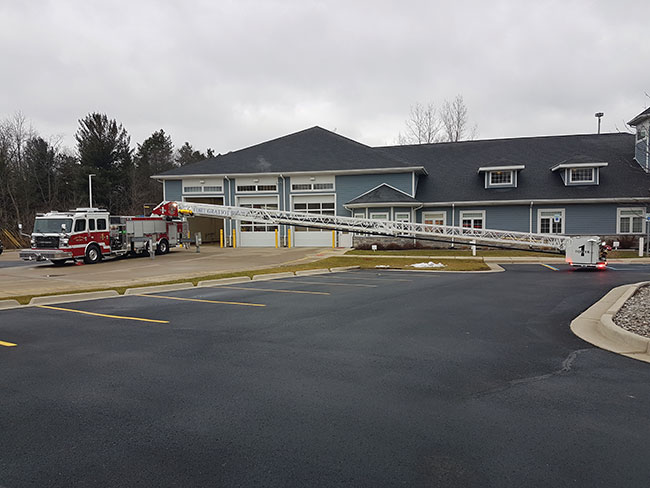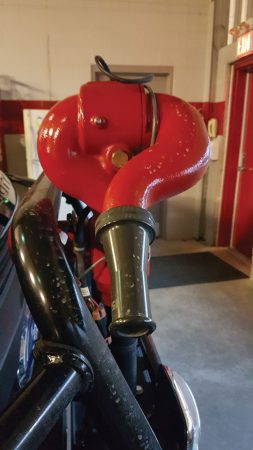
Features
Training
Back to Basics: Cold weather truck checks
February 16, 2022
By Mark van der Feyst
 It is a good idea to fully extend the ladder and have it at 0 degrees to one side. This will allow you to walk underneath it to inspect the water pipe, the sheave wheels, the cables, and grease on the ladder rails. Photo credit: Mark van der Feyst
It is a good idea to fully extend the ladder and have it at 0 degrees to one side. This will allow you to walk underneath it to inspect the water pipe, the sheave wheels, the cables, and grease on the ladder rails. Photo credit: Mark van der Feyst As we start a new year in the fire service, we find ourselves in the middle of winter, which requires us to be diligent in making sure our equipment is in good working order. In cold weather operations, it is imperative to make sure our trucks are running properly and safely.
It is our job to check in our fire apparatus on a routine basis. This may be on a daily, weekly, bi-weekly, or monthly schedule. By conducting a check of our fire apparatus on a regular basis, we are ensuring that the fire apparatus is ready for service in a safe manner.
When checking in any type of truck, there are four basic areas that need to be addressed: outside, inside, operations and equipment. If these four areas are checked consistently every time, then you will have completed a thorough truck check.
On the outside
To check the outside of the truck, we need to have the truck running with certain apparatus functions operating. By conducting a full 360 walk around, we will inspect the entire truck. The outside of the truck includes areas such as general appearance; does the truck have any damage on the body?). Check all windows for cracks and chips. Are the windows clean? Are the mirrors attached securely, and are the wiper blades in good condition? Check the tires. Are they inflated to the proper pressure? Is tread depth above par? What condition are the tires in? Are the lug nuts secure? Are there any rocks in between the back dual tires? To assess the lights, ask are the headlights, high beams, hazard lights, and emergency lights working? Are any bulbs, turn signal indictors, running lights or pump panel lights out? Are any lenses damaged?
For the air brakes systems, drain the air tank reservoirs and any air leaks.
Check that the compartment doors open and close properly. Make sure any equipment attached to the truck on the outside is secure.
Ensure current sticker is on the licence plate, both plates are on the truck if two are required, and the commercial inspection sticker is present and current.
On the inside
The inside of the truck needs to be checked for proper operation. The driver needs to ensure that the truck is ready for them to drive. They will need to adjust the driver seat for proper distance and height, adjust the mirrors, and adjust the telescoping steering wheel as well. Other aspects of the inside include checking all gauges on the driver dashboard, fuel, air gauges, oil temp, transmission oil pressure gauge. Ensure all switches and signals are working. Are all interior lights working?
Ensure that the siren functions work along with air horn.
Conduct an air brake test to ensure that all safety features of the system are working.Check all fluids such as oil, transmission fluid, power steering fluid, windshield washer fluid, radiator levels, hydraulic fluid, brake fluid, belts for wear and tear, battery terminals for corrosion, and hoses for cracks.

Other equipment that is on the truck like hand tools, medical bag, defibrillator, SCBA bottles, nozzles, and hose will need to be checked as well. Photo credit: Mark van der Feyst
Truck operations
The operations of the apparatus need to be checked. This will involve operating the pump on most trucks. Items such as the pump heater, cooling function, drains for each discharge and intake port, foam system (if so equipped) and the primer (the primer should be operated for about five to 10 seconds to ensure that it will work and get the air out of the pump).
For aerial devices, the ladder needs to be operated. Along with the operation of the ladder, the outriggers need to be operated and the devices attached to the ladder need to be operated. Each aerial truck is different with their setup procedures. Following the manufacturer’s procedures is important.
There are safety systems that are built into aerial devices when they are being set up. The safety systems allow one function to be operated at one time when setting up, or if it is not set up properly, they will prohibit certain functions. An example would be the outriggers. There will be a limiter switch on the outrigger that reads if the outrigger is fully extended or not. If it is, it will allow the aerial device to operate fully. If the outrigger is not fully extended, it will prohibit certain functions from operating. Ensuring that these safety systems work properly is an important item to check.
Operating the aerial device, whether it is a straight stick or a platform, is essential. The aerial device needs to be extended fully and rotated a full 360 degrees. It is a good idea to fully extend the ladder and have it at zero degrees to one side. This will allow you to walk underneath it to inspect the water pipe, the sheave wheels, the cables, and grease on the ladder rails. You should operate the nozzles, any communicating devices, and auxiliary outlets. Once done, the aerial device can be bedded.
All scene lights should be operated using the on-board generator. Many rescues, engines and ladder truck have these items. For rescues, they will have other items that need to be operated, like a winch system.
Truck equipment
All trucks carry equipment. The equipment they carry will depend upon the operation of the apparatus. When checking the truck, you will need to operate all mechanical equipment such as chain saws, circular saws, positive pressure fans, hydraulic auto ex tools, and thermal cameras to ensure that they are working properly. Other equipment that is on the truck like hand tools, medical bag, defibrillator, SCBA bottles, nozzles, and hose will need to be checked as well.
If you check the following four areas, outside, inside, operations and equipment, you will be ensuring that the fire apparatus is ready for service and ready for cold weather operations. •
Mark van der Feyst has been in the fire service since 1999 and is currently a firefighter with the FGFD. He is an international instructor teaching in Canada, the United States, FDIC and India. Contact him at Mark@FireStarTraining.com.
Print this page